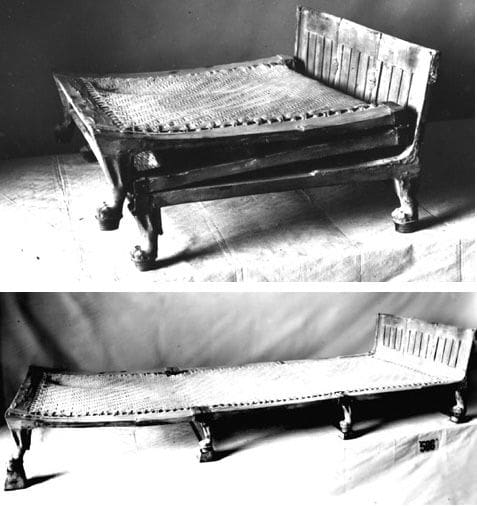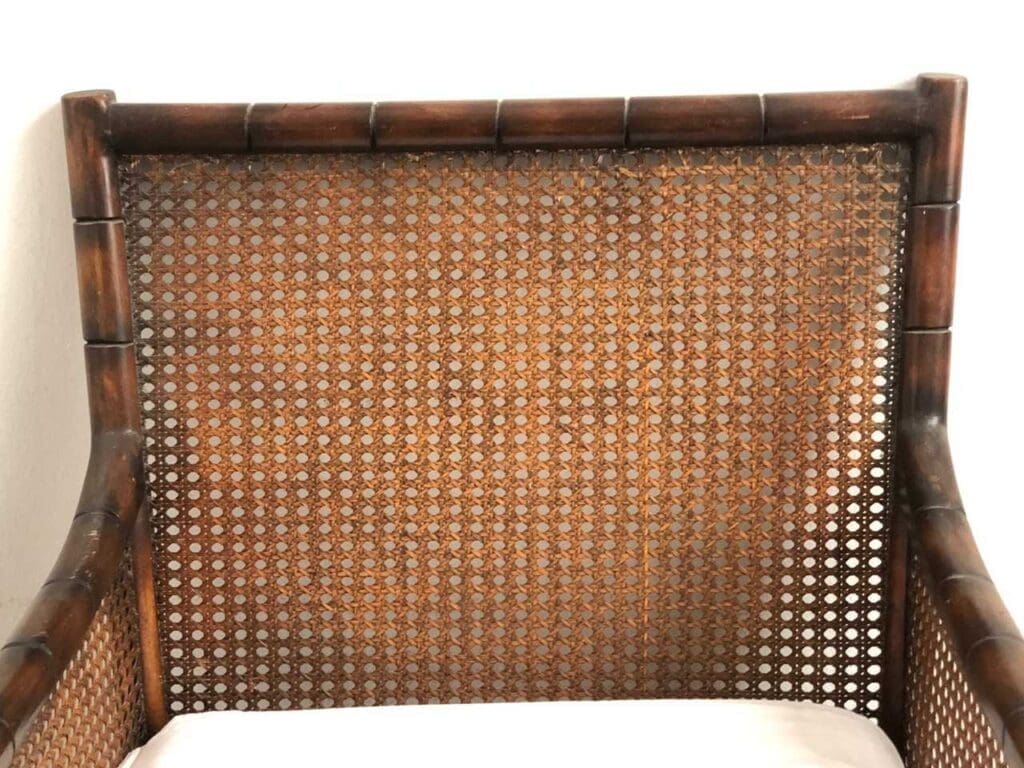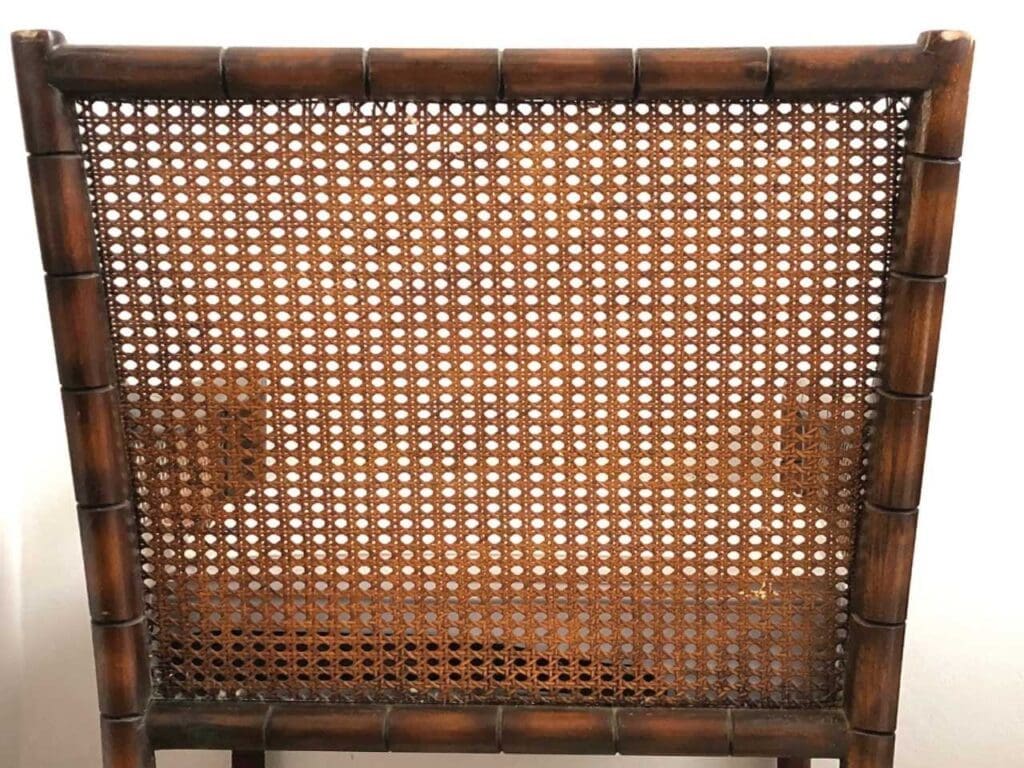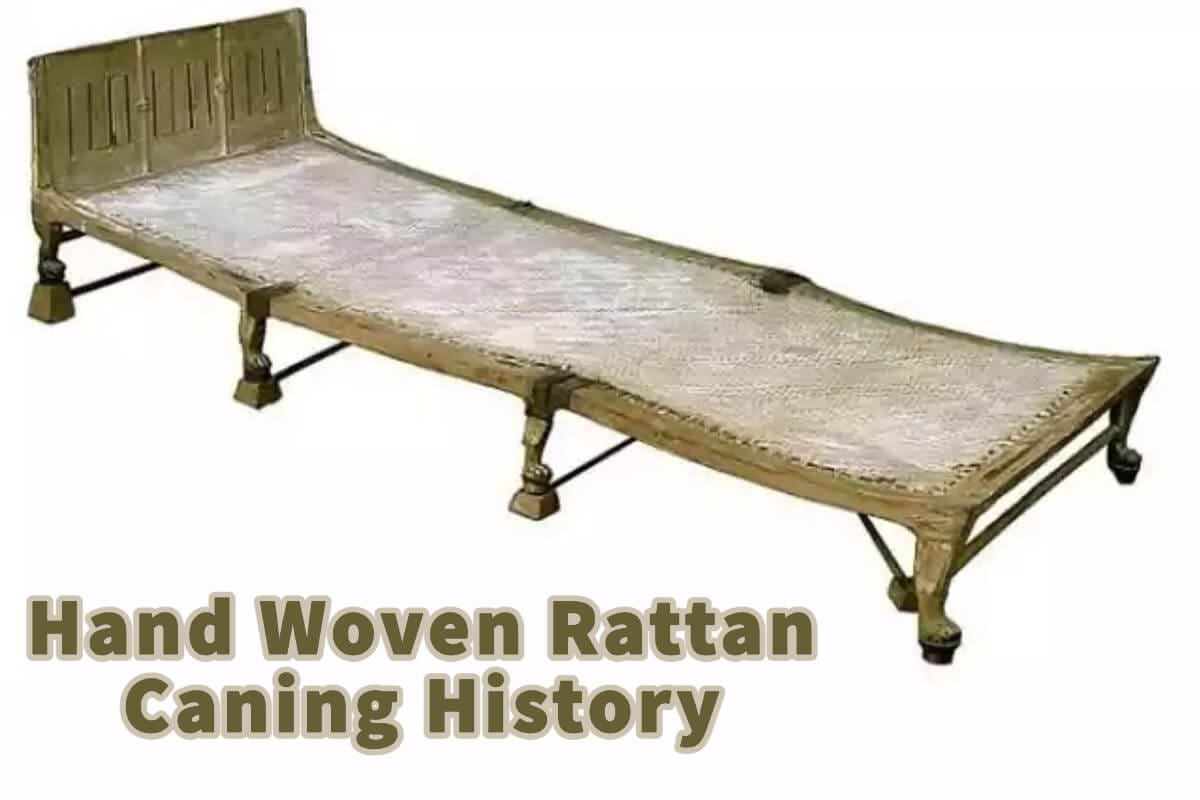Handwoven caning has a long and varied history. It is a technique that has been used for thousands of years.
The art of caning goes back to ancient Egyptian times. Archaeologists found a King Tuk folding day or camping bed with a woven mattress on the bed frame; this was an example of some of the first types of caning. Caning also became popular in Europe in the 1600s, and by the mid-1800s, most of the cafe chairs found in Europe were Bistro chairs with caned seats.
Table of Contents
- The Ancient Art Of Handwoven Caning
- Caning And England Started In The Mid-1600s
- Colonial Furniture And Caning
- Frequently Asked Questions
- Related Content
The Ancient Art Of Handwoven Caning
Caning continues to be a popular look for the Home Furnishing and Home Decor Industry today. When many of us think of caning, we think of Europe in the 18th or 19th centuries and many of the antiques and other furniture we see from this era.
Caning was found in artifacts handcrafted over 3,300 years ago. This makes caning an essential ancient craft. Even though most people think of caning as just one type of weave, caning can also be a variety of weaves.
King Tut’s Caning Daybed – 1325 BC
King Tutankhamun, also known simply as King Tut, is thought to have lived from about 1343 BC to 1323 BC or more than 3,300 years ago in ancient Egypt.
From King Tutankhamun, we can learn how ancient the art of weaving caning is. King Tutankhamun was thought to sleep when he traveled on a portable daybed that looks like the forerunner to our modern-day camping bed.

British archaeologist Howard Carter entered King Tut’s tomb in 1922. The tomb was so packed with treasures that one artifact that many people set aside was the King’s daybed.
Carter found several pieces of furniture in the tomb, which included five regular beds. But also found a smaller amount of furniture that was thought to be a daybed or camping bed as it sat lower to the ground.
A unique feature of this bed was that it was also folded up into three parts or a Z-kind of shape. The Z shape would have allowed the bed to be transported easily while also giving a comfortable bed for King Tut to sleep on.
Carter must have been intrigued by the bed as he sketched it out over 100 years ago. Since then, the bed was pretty much forgotten.
Here are a few aspects of the folded cane daybed:
- Was Made To Be Portable – The folded cane day bed was portable.
- Cane Is Woven On Frame – The bed has a woven mat woven into the wooden frame, similar to how many other caning or woven beds would be made today. The weave was attached to the wooden frame.
- Comfortable Bed – This bed was thought to show some of the best form and function as the bed had intricately carved legs, bronze hinges, and a woven cane mat. It would have been a very comfortable bed.
- High-Level Craftsmanship – The bed shows a high level of Egyptian craftsmanship that dates back thousands of years.
- Caning Is An Ancient Art – The bed shows us that caning is an ancient art, much older than anyone thought.
Caning And England Started In The Mid-1600s
Caning was popular in England. One of the first pieces of evidence of chair caning in Europe was shortly after Charles II married Catherine of Braganza in 1661. Portugal was known to have a caning in furniture before the rest of Europe. Some historians believe Catherine brought some caned chairs to England from Portugal, but no concrete evidence exists to verify this.
We do know that the first caned chairs started to appear in London about this time or about 1661. They very quickly became fashionable.
As caning became a popular trend in London during this time, basket makers were weaving the chairs, but eventually, caning developed as a distinct craft and skill.
Basket makers were using rattan, a waste material from cases of tea making the journey from China. Eventually, cane and the import of rattan material became famous for furniture as the rattan was better than the local alternative of willow.
We also know that caning spread to other parts of Europe, particularly France and Holland. Both France and Holland also saw cane furniture appear in the 1660s.
A few reasons why caning in chairs became popular in Europe were:
- Considered Hygienic – We may forget that many of our forefathers lived in conditions that were not hygienic and were filled with critters such as lice, worms, or even moths. Caning in chairs was considered more hygienic than many of the other counterparts. This would have been an era when many cushions were stuffed with hay, horse, or animal hair, which is probably also not hygienic.
- Non-Itchy – Cushions and fabric during this time were more than likely itchy. The caning was not itchy, as many fabrics during this time would not have been the soft, cozy fabrics we know today.
- Durable – Besides being hygienic, the cane chairs were also very durable. They were lightweight yet durable.
- Less Formal – The caned chairs were less formal than many other chairs.
Colonial Furniture And Caning
In the 19th century, caning became popular for colonial furniture in England, France, and Holland. This is because all these countries had colonies in places like Indonesia, India, Vietnam, and Cambodia, where cane was readily available.
I own an old Shanghai rocking chair that has a woven seat. The woven seats, including caning, were common throughout all kinds of antique furniture, especially furniture in the European colonies in Asia.


A caning chair that has a woven seat.
You can find many classic ancient Chinese opium beds with a woven mat on the bed. There are many reasons for this; one is that it was more hygienic to have a woven mattress. Another was that it was simply cooler to sleep on a bed with a mat than to have a mattress stuffed with straw or horsehair.
Also, the caning chairs spread to the United States or the Americas as the English and others started bringing their furniture to the American colonies. So, caning was also found in the Americas.
Michael Thonet (1859) – Cafe Chair No. 14 Or Bistro Chair

We can not talk about the history of caning chairs without mentioning Michael Thonet’s No 14 Cafe Chair, which had a caned seat. By the mid-19th century, caning became one of the most popular seat materials. Thanks to Michael Thonet’s No 14 chair, so did his bistro chair.
Today, the classic design of this bistro chair can still be found worldwide. The original No 14 chair, also known as the bistro chair, was designed by Michael Thonet and introduced in 1859.
The chair was so popular it became the world’s first mass-produced item of furniture. Between 1859 and 1930, it is estimated that at least 50 million No 14 chairs were produced and sold.
That means they produced over 700,000 chairs per year or 58,000 per month. That is a huge amount of production. Since then, millions more have also been made, and it must be one of the most popular chair styles ever produced.
The seat of the No 14 chair was usually made from woven cane or palm. And the wood is a bentwood method that Thonet perfected.
The chair is still being produced today by the Grubder Thonet, also known as the Thonet Brothers in Europe.
Caning on furniture has a long and varied past. It continues to be popular today for many of the reasons it was popular so many years ago. Caning is lightweight, durable, and hygienic. It is a beautiful material to use for any product.
If you are interested in seeing how Mondoro can help you with your rattan or caning furniture and other home decor products – we would love to talk to you about how we can help you.
Find out more about how Mondoro can help you create, develop, and manufacture excellent home decor and furniture products – don’t hesitate to contact me, Anita. Check out my email by clicking here or become a part of our community and join our newsletter by clicking here.
Mondoro gives out a FREE Lookbook to anyone interested. You can receive a copy of our latest Lookbook by clicking here.
Listen to our Podcast called Global Trade Gal. You can find it on all major podcast platforms. Try out to listen to one of our podcasts by clicking here.
Subscribe to our Mondoro Company Limited YouTube Channel filled with great videos and information by clicking here.
Frequently Asked Questions
What is handwoven rattan caning?
Handwoven rattan caning is a traditional weaving technique used to create intricate patterns and designs using rattan cane, a flexible and durable material. It is commonly used to construct chair seats, backs, and other furniture pieces.
When did the history of handwoven rattan caning begin?
The history of handwoven rattan caning dates back thousands of years, with evidence of its use found in ancient Egyptian furniture, including beds with woven mattresses on the bed frames.
How did handwoven rattan caning evolve over time?
Handwoven rattan caning gained popularity in Europe during the 1600s and underwent various stylistic changes and innovations. By the mid-1800s, it was a prominent feature in European cafe chairs, such as the iconic Bistro chairs.
What materials are used in handwoven rattan caning?
Handwoven rattan caning primarily uses rattan cane, a flexible and slender vine, as the weaving material. Rattan cane is known for its strength and flexibility, making it ideal for intricate weaving patterns.
Who were some notable figures associated with handwoven rattan caning?
While there aren’t specific individuals credited with the invention of handwoven rattan caning, artisans and craftsmen across cultures have contributed to its development and popularization over the centuries.
What are the key characteristics of handwoven rattan caning designs?
Handwoven rattan caning designs often feature geometric patterns, floral motifs, and intricate weaves that provide both aesthetic appeal and structural support to furniture pieces.
Did handwoven rattan caning have cultural significance in different regions?
Yes, handwoven rattan caning has cultural significance in various regions, with different cultures incorporating unique designs and styles into their furniture. It has been used in both functional and decorative capacities.
How has the use of handwoven rattan caning evolved in modern times?
In modern times, handwoven rattan caning continues to be appreciated for its craftsmanship and timeless appeal. It is often used in the production of vintage-inspired or bohemian-style furniture.
Are there any preservation efforts for handwoven rattan caning traditions?
Yes, there are efforts to preserve traditional handwoven rattan caning techniques and knowledge. Artisans and organizations work to pass down these skills to future generations and promote the appreciation of this craft.
Where can one find handwoven rattan caning furniture today?
Handwoven rattan caning furniture can be found in antique shops, specialty furniture stores, and online marketplaces. It continues to be a popular choice for those seeking timeless and aesthetically pleasing furniture pieces.
Related Content
Care & Maintenance Of Outdoor Synthetic Rattan Furniture
The care and maintenance of the outdoor synthetic rattan furniture are pretty straightforward. Use mild soap and water and a soft brush to clean your furniture at least once a year. With proper storage, you can be sure to add to the longevity of your outdoor synthetic rattan furniture pieces.
You can discover more by reading Care & Maintenance Of Outdoor Synthetic Rattan Furniture by clicking here.
Can You Paint Plastic Rattan Or Faux Rattan Furniture?
The short answer is that you should not paint your plastic or faux rattan furniture. The plastic or faux rattan material is not made or manufactured to be painted. If you paint on your plastic or faux rattan furniture, the paint will eventually peel and crack; the painting could also damage the furniture.
You can learn more by reading Can You Paint Plastic Rattan Or Faux Rattan Furniture? by clicking here.
How To Bend And Shape Rattan
Rattan can be bent and shaped in a variety of ways. The rattan must first be pliable so that it can be bent. Several methods are used to accomplish this. Once the rattan is pliable, it can be shaped in various ways.
You can learn more by reading our blog, How To Bend And Shape Rattan by clicking here.

